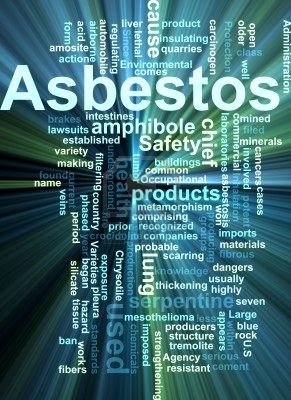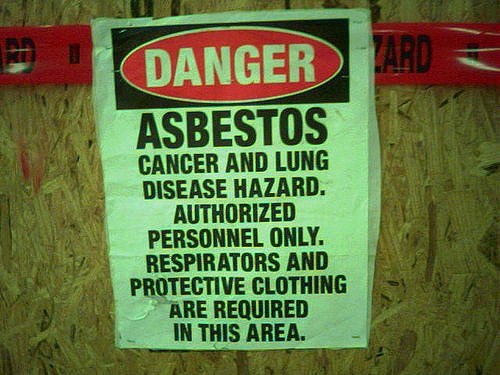
Asbestos
|
The information on this page is adapted from toxipedia.org. To learn more about Toxipedia’s integration into our website, visit our Toxipedia webpage. |
Asbestos is a mineral naturally found in rock and soil in many places around the world. Although asbestos has been useful in many products, its health impacts can be devastating.
Asbestos is the common name given to a group of six different naturally occurring fibrous minerals. Each of these minerals can be separated into long fibers that can be spun and woven. The woven material is strong, flexible, and resistant both to heat and to most solvents and acids, making it a very useful industrial product.
Because of these properties, asbestos has been intentionally added to everyday materials, including these:
-
Sheetrock taping
graphic from Asbestos Testing at Creative Commons
- Mud and texture coats
- Vinyl floor tiles, sheeting, adhesives and ceiling tiles
- Plasters and stuccoes
- Roofing tars, felts, siding and shingles
- “Transite” panels, siding, counter tops and pipes
- Acoustical ceilings
- Fireproofing materials
- Brake pads
- Putty
- Caulk
- Gaskets
- Clutch plates
- Stage curtains
- Fire blankets
- Interior fire doors
- Stage curtains
- Building insulation1
Health Impacts
Asbestos has been classified for decades as a proven human carcinogen by the US Environmental Protection Agency,2 the International Agency for Research on Cancer (IARC)I3 of the World Health Organization (WHO), and the US National Toxicology Program.4 There is no "safe" level of asbestos exposure for any type of asbestos fiber.5
The majority of impacts may occur many years after initial exposure. The most common health effects are these:
- Asbestosis: a lung disease in which tissue scarring makes breathing difficult6
- Mesothelioma: cancer of the lining of the lungs, which is almost exclusively associated with asbestos exposure7
Symptoms, which may not appear for 10 to 20 years after initial exposure, can include these:8
- Shortness of breath
- A persistent and productive cough
- Tightness in chest
- Chest pain
Evidence links asbestos to these diseases:9
| Strong Evidence | Good Evidence |
|---|---|
|
|
Costs. A 2015 report found that new cases of asbestos-related cancer in 2011 cost Canada $1.7 billion per year, with the average lifetime cost per case at $818,000.10
Groups Especially at Risk
Cigarette smokers and individuals with existing lung disease are at increased risk from asbestos exposure. Exposure to cigarette smoke, together with exposure to asbestos, leads to a greatly increased risk of lung cancer.11
Children exposed to asbestos are also at a higher risk of developing asbestos-related diseases due to their longer expected lifespan after exposure.
Exposure
From the 13th Report on Carcinogens:12 Asbestos is released to the environment from both natural and anthropogenic (human-caused) sources and has been detected in indoor and outdoor air, soil, drinking water, food, and medicines. Because asbestos products were used so widely, the entire US population potentially is exposed to some degree; however, the potential for exposure continues to decline because asbestos mining has stopped and because asbestos products are being eliminated from the market. Typical sources of exposure include these:
-
Building materials13
image from Aaron Suggs at Creative Commons
- Work environments such as these:14
- Asbestos product manufacturing
- Mining
- Automotive repair
- Building construction
- Power plants
- Steel mills
- Maritime operations
- Offshore rust removals
- Sand or abrasive manufacturing
The World Health organization estimates that about 125 million people in the world are exposed to asbestos at the workplace.15
The most typical routes of asbestos exposure include inhalation and ingestion. Absorption through skin is minimal, but residues on skin can be ingested or inhaled. Thinner fibers have the greatest potential to be inhaled deeply into the lungs.16
Asbestos fibers can be carried home to family members by people who are exposed at work. Unless asbestos fibers are carefully cleaned from skin, clothes and hair before leaving the workplace, family members may be exposed through contact with the worker's clothing, skin and hair, and also through contact with furniture, automobile interiors and other items shared with workers.
Asbestos in products which are in good condition is usually harmless, as the asbestos fibers are not being released.17
Preventing or Reducing Exposures
Safe work practices are critical to reducing exposure to asbestos for both the workers and their families. EPA outlines proper cleaning procedures which explicitly explain the safest way to clean the work environment after working with asbestos. Proper training of all those working with asbestos is critical, as being educated on the dangers and safe practices help reduce the risk of accidental exposure.18
Proper protective clothing and equipment are critical to reducing the inhalation, ingestion and dermal exposure to asbestos. Disposable coveralls and head and foot covers made of a special synthetic fabric stop asbestos from passing through.19
Because smoking cigarettes multiples the risk of harm from asbestos exposure, those who are exposed to can stop smoking, This is also true for individuals with pre-existing lung disease.20
Tampering with products containing asbestos, such as remodeling a home, can lead to exposure to harmful fibers. Home and building remodelers should consult trained professionals who can determine if asbestos is present before work begins and can then safely remove it if needed.21
Banning asbestos production and use is an obvious way to reduce exposures in the long term. By 2010, all forms of asbestos had been banned in 52 countries, and safer products are replacing those made with asbestos.22 Unfortunately, asbestos has been so widely used that its effects will still be a concern for decades after a total ban.
The US National Institute for Occupational Safety and Health has estimated that current occupational exposures to asbestos, even at the US Occupational Safety and Health Administration (OSHA) permissible exposure limit, will cause five deaths from lung cancer and two deaths from asbestosis in every 1,000 workers exposed for a working lifetime. An estimated 20,000 asbestos-related lung cancers and 10,000 cases of mesothelioma occur annually across Western Europe, Scandinavia, North America, Japan and Australia.23
History and Ethics
![]() Serious lung disease associated with asbestos inhalation was first described in the early 1900s in England. This disease became known as asbestosis and was fully described in British medical journals in 1924 as young workers died from asbestos exposure. By the early 1930s, dose-related injury, length of time exposed, and the latency of response were being well characterized in both Europe and the United States. By the mid and late 1930s the first associations with lung cancer were documented. In the 1960s the consequences of asbestos exposure for many workers in World War II started to become evident. Mesothelioma, a cancer of the lining of the lung, was found to be almost exclusively associated with asbestos exposure.24
Serious lung disease associated with asbestos inhalation was first described in the early 1900s in England. This disease became known as asbestosis and was fully described in British medical journals in 1924 as young workers died from asbestos exposure. By the early 1930s, dose-related injury, length of time exposed, and the latency of response were being well characterized in both Europe and the United States. By the mid and late 1930s the first associations with lung cancer were documented. In the 1960s the consequences of asbestos exposure for many workers in World War II started to become evident. Mesothelioma, a cancer of the lining of the lung, was found to be almost exclusively associated with asbestos exposure.24
In the United States, asbestos garnered the attention of the Occupational Safety and Health Administration (OSHA) and the Environmental Protection Agency (EPA) in the early 1970s.25 Regulation of asbestos exposure started in the early 1970s, with exposure limits rapidly decreasing as the serious and latent consequences of asbestos exposure became apparent.
In 1979, the EPA issued a notice of its intent to regulate asbestos under the authority of Section 6 of the Toxic Substances Control Act (TSCA). In 1989, after conducting a ten-year study, spending ten million dollars, and accumulating a 100,000-page administrative record, EPA announced that it would phase out and ban virtually all products containing asbestos. EPA's efforts were met with fierce opposition from asbestos producers and the Canadian government, who brought suit against the EPA ban. In 1991 the Fifth Circuit vacated the ban, finding that EPA failed to present "substantial evidence" to justify the ban under TSCA.26 The court overturned most of the 1989 ban on the manufacture, importation, processing, or distribution in commerce for the majority of the asbestos-containing products. A handful of asbestos-containing products were banned:27
|
|
In June 2016, the Frank R. Lautenberg Chemical Safety for the 21st Century Act was signed into law, amending TSCA.28
As this is written in 2016, asbestos continues to be mined and used in manufacturing even though the health impacts are beyond dispute and human suffering, economic costs and rates of premature death are substantial.
See more about asbestos and health in the list of CHE publications and Dig Deeper resources in the right sidebar.
This page was last revised by student intern Eva Bauer and Nancy Hepp in July 2016.
CHE invites our partners to submit corrections and clarifications to this page. Please include links to research to support your submissions through the comment form on our Contact page.
* header image from DrButtsMD at Creative Commons


